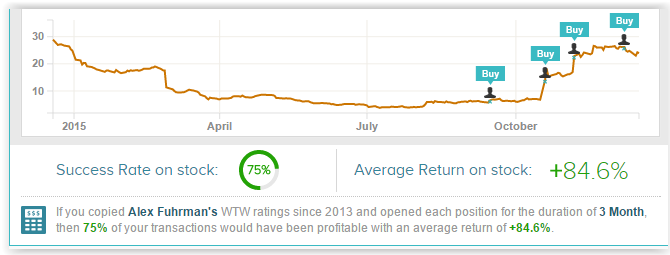An analyst must give a stock the correct rating at the right time in order to make a profit. Let’s take a look at the most profitable consumer goods sector ratings of 2015.
1. The most profitable rating of 2015 for the consumer goods sector was made by Craig-Hallum analyst Alex Fuhrman for Weight Watchers International, Inc. (NYSE: WTW) on September 19, 2015. The analyst upgraded the stock to Buy after citing positive results from the company’s new marketing plan, which caused the stock to surge. Launched last year, the company worked on several marketing initiatives to stay competitive with new technologies such as apps and fitness trackers. Of these initiatives was the “Help with the Hard Part” campaign, which replaced celebrities and presented a more honest approach to weight loss. As a result, the analyst stated that the company’s website reached peak levels for unique online visitors in September. The stock surged again following October’s announcement that Oprah Winfrey joined the company’s board and purchased a 10% stake in the company.
On the day of Fuhrman’s rating, shares of Weight Watchers were trading at $6.79. Three months later, the stock surged to $24.23. If you had purchased shares of Weight Watchers when Fuhrman suggested, you would have made a 252% profit in three months. Alex Fuhrman has a 75% success rate recommending Weight Watchers with an average return of 84.6% per recommendation when measured over three months.

2. Anne Shih of Brean Capital made the second most profitable 2015 consumer goods rating when she recommended buying China Distance Education Hldgs Ltd (ADR) (NYSE:DL) on August 20, 2015. The analyst maintained a Buy rating on the company but lowered her price target to $14 from $23 following the company’s disappointing Q315 earnings report. The company lowered guidance, citing slow enrollment growth. However, the analyst remained hopeful about the company’s leverage during enrollment. She stated, “Though DL’s pure online business model leads to disproportionately negative impact on margin during enrollment downturns, on the other hand, the company gains leverage with each incremental enrollment during periods of growth.” Although the disappointing earnings release caused her to lower her price target, she believed that “mid- to longer-term there may be potential upside from more meaningful contribution from new revenue drivers (teacher training, college cooperation, etc.). Consequently, we are maintaining our Buy rating.” She also cited the company’s leading position in the market.









Leave A Comment